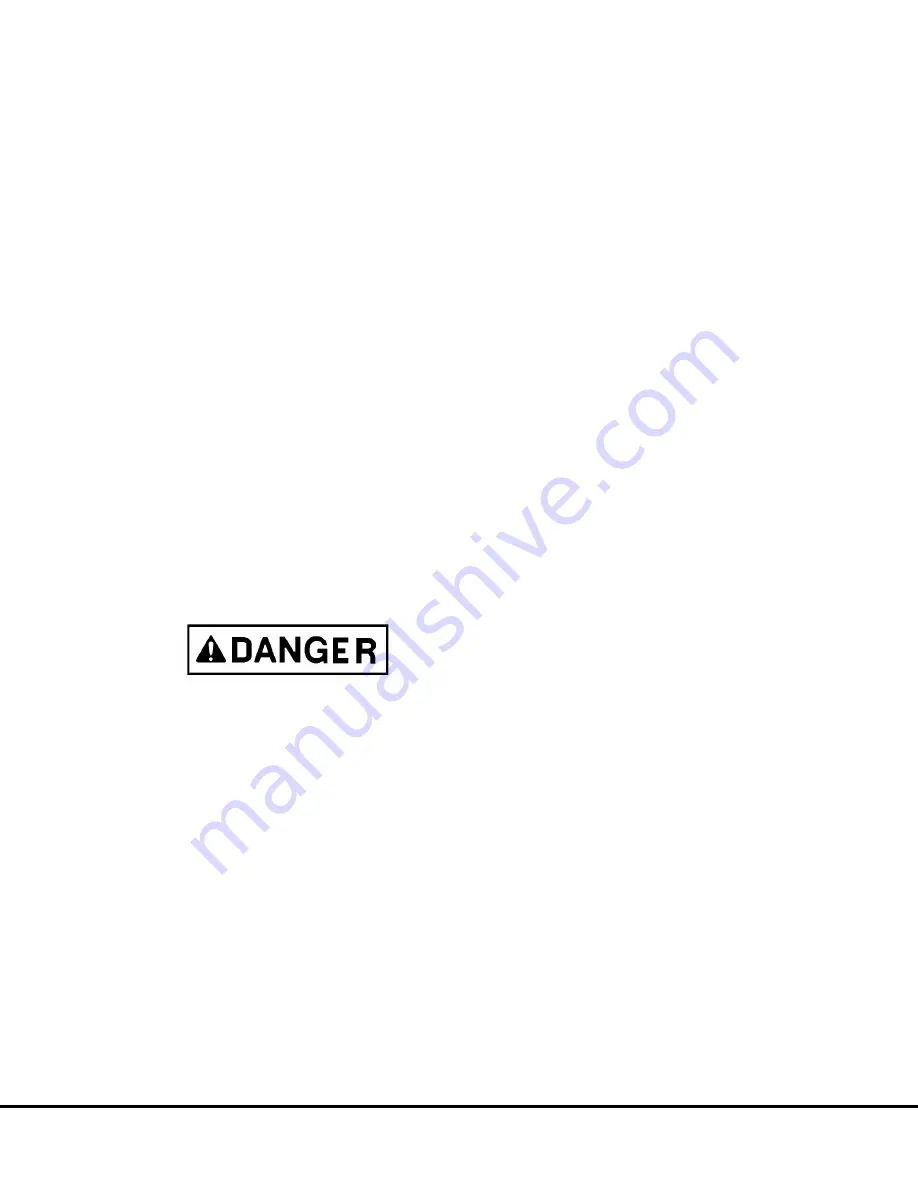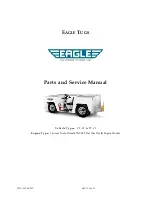
DUAL RELAY VALVE
The dual relay valves (one for front and one for rear
brake circuits) supply the apply pressure for each disc
brake assembly. When the operator depresses the
brake valve, hydraulic pressure, proportional to the
amount of brake valve application, is applied to the
pilot pressure circuit of each dual relay valve. Regu-
lated pressure (proportional to the pilot pressure ap-
plied) is then delivered from the “B1” and “B2” ports of
each dual relay valve to each wheel.
The regulated pressures supplied to each wheel are
equal. If a malfunction occurs, causing a pressure
differential greater than 300 psi (2068 kPa) between
the right and left brake apply circuit, a differential
pressure switch (3, Figure 3-11) mounted on the valve
activates a warning horn and lamp in the cab. If a
pressure differential greater than 300 psi (2068 kPa)
occurs in the pilot circuit supplying the front and rear
dual relay valves, a differential pressure switch
mounted on the brake valve activates the warning horn
and lamp in the cab.
The dual relay valve for the front brake circuit is located
in the hydraulic components cabinet behind the cab.
The dual relay valve for the rear brake circuit is located
in the rear axle housing and requires removal of the
wheel motor cooling air duct components for access
to the valve as described below.
Before disconnecting pressure lines, replacing
components in the hydraulic circuits, or installing
test gauges, always bleed down hydraulic steering
and brake accumulators. The steering accumula-
tors can be bled down with engine shut down,
turning the key switch “Off” and waiting 90 sec-
onds. Confirm the steering pressure is released by
turning the steering wheel - No front wheel move-
ment should occur.
Open bleed down valves (6 & 7, Figure 3-1) located
on the brake manifold. This will allow both accu-
mulators for the rear brakes and both accumula-
tors for the front brakes to bleed down.
Before disabling brake circuit, be sure truck
wheels are blocked to prevent possible roll-away.
Removal
1. Securely block the wheels to prevent possible
roll-away.
2. Place selector switch in NEUTRAL, turn the rest
switch ON. Turn key switch OFF to shut down
engine and allow 90 seconds for steering system
accumulators to bleed down. Open valves (6 & 7,
Figure 3-1) to bleed down all four brake accumu-
lators. Close valves after all pressure is released.
NOTE: Follow steps 3 & 4 below for the front valve or
steps 5 through 9 for rear valve removal.
Front Brake Circuit:
3. Tag and remove all hydraulic lines from dual relay
valve. Plug lines and ports to prevent possible
contamination. Disconnect wiring harness at dif-
ferential pressure switch connector.
4. Remove two capscrews and washers securing
valve to rear wall of cabinet. Remove valve and
move to clean work area for disassembly.
Rear Brake Circuit:
5. Open rear access cover and remove wing nuts
securing duct tube to axle housing. Remove tube.
6. Open access covers inside axle housing.
7. Remove wheel motor cooling air exhaust duct
from between wheel motors.
8. Tag and remove all hydraulic lines from dual relay
valve. Plug lines and ports to prevent possible
contamination. Disconnect wiring harness at dif-
ferential pressure switch connector.
9. Remove two capscrews and washers securing
valve to mounting bracket. Remove valve and
move to clean work area for disassembly.
Installation.
1. Install dual relay valve in hydraulic components
cabinet (front brake circuit) or rear axle housing
(rear brake circuit). Install the two mounting cap-
screws and lockwashers to secure valve. Tighten
capscrews to standard torque.
2. Remove hose and fitting caps and plugs and
attach hoses to the proper valve ports. Connect
differential pressure switch connector to wire har-
ness.
3. Start engine and check for leaks and proper brake
operation. Shut down engine.
4. For the rear valve, reinstall the wheel motor cool-
ing air duct between wheel motors. Close access
covers and reinstall tube in axle access opening.
J03019 1/99
Brake Circuit Component Service
J3-15
Summary of Contents for 930E-2
Page 1: ......
Page 2: ......
Page 4: ...NOTES ...
Page 8: ...KOMATSU MODEL 930E Dump Truck A 4 Introduction A00017 03 01 ...
Page 10: ...NOTES A1 2 Index A01001 2 94 ...
Page 12: ...930E MAJOR COMPONENTS A2 2 Major Component Description A02055 ...
Page 35: ...START HERE Walk Around Inspection A03017 General Safety and Operating Instructions A3 21 ...
Page 46: ...NOTES A3 32 General Safety and Operating Instructions A03017 ...
Page 78: ...NOTES B1 2 Index B01016 ...
Page 88: ...NOTES B3 6 Dump Body B03013 03 01 ...
Page 92: ...NOTES B4 4 Fuel Tank B04015 ...
Page 94: ...NOTES C1 2 Index C01021 03 01 ...
Page 118: ...NOTES C5 6 Air Filtration System C05013 5 98 ...
Page 126: ...NOTES D2 6 24VDC Electric Supply System D02018 ...
Page 142: ...NOTES D3 16 24VDC System Components D03019 04 01 ...
Page 146: ...FIGURE 2 1 PROPULSION SYSTEM DIAGRAM E2 2 Electrical Propulsion System Components E02014 3 01 ...
Page 196: ...NOTES E2 52 Electrical Propulsion System Components E02014 3 01 ...
Page 240: ...NOTES E3 44 AC Drive System Electrical Checkout Procedure 3 01 E03015 Release 17 Software ...
Page 242: ...NOTES G1 2 Index G01017 ...
Page 250: ...NOTES G2 8 Tires and Rims G02015 ...
Page 274: ...NOTES H1 2 Index H01013 04 01 ...
Page 282: ...NOTES H2 8 Front Suspensions H02013 2 01 ...
Page 288: ...NOTES H3 6 Rear Suspensions H03013 ...
Page 334: ...NOTES J3 32 Brake Circuit Component Service J03019 1 99 ...
Page 378: ...NOTES L2 8 Hydraulic System L02028 ...
Page 401: ...FIGURE 4 5 FLOW AMPLIFIER VALVE L04031 Steering Circuit L4 7 ...
Page 403: ...FIGURE 4 6 FLOW AMPLIFIER NO STEER L04031 Steering Circuit L4 9 ...
Page 405: ...FIGURE 4 7 FLOW AMPLIFIER LEFT STEER L04031 Steering Circuit L4 11 ...
Page 407: ...FIGURE 4 8 FLOW AMPLIFIER RIGHT STEER L04031 Steering Circuit L4 13 ...
Page 409: ...FIGURE 4 9 FLOW AMPLIFIER NO STEER EXTERNAL SHOCK LOAD L04031 Steering Circuit L4 15 ...
Page 414: ...NOTES L4 20 Steering Circuit L04031 ...
Page 422: ...NOTES L5 8 Steering Control Unit L05021 ...
Page 429: ...L06021 Steering Circuit Component Repair L6 7 ...
Page 450: ...NOTES L6 28 Steering Circuit Component Repair L06021 ...
Page 466: ...NOTES L7 16 Hoist Circuit L07023 ...
Page 492: ...NOTES L9 6 Hydraulic System Filters L09008 ...
Page 504: ...NOTES L10 12 Hydraulic Check out Procedure L10012 ...
Page 508: ...NOTES M1 2 Index M01034 03 01 ...
Page 518: ...NOTES M2 3 10 Ansul Checkfire Electric Detection and Actuation System M02003 ...
Page 524: ...NOTES M5 4 Wiggins Quick Fill Fuel System M05002 10 96 ...
Page 532: ...NOTES M8 8 Special Tools M08012 9 99 ...
Page 560: ...NOTES M9 28 Air Conditioning System M09010 6 97 for HFC 134a Refrigerant ...
Page 618: ...M20 20 Payload Meter II M20007 10 00 ...
Page 619: ...M20007 10 00 Payload Meter II M20 21 ...
Page 627: ...M20007 10 00 Payload Meter II M20 29 ...
Page 634: ...NOTES N1 2 Index N01020 03 01 ...
Page 654: ...NOTES N3 6 Cab Components N03011 7 98 ...
Page 660: ...NOTES N4 6 Operator Comfort N04020 ...
Page 686: ...NOTES N5 26 Operator Cab Controls N05044 ...
Page 688: ...NOTES P1 2 Index P01024 ...
Page 691: ...P02034 Lubrication and Service P2 3 ...
Page 722: ......
Page 723: ......
Page 724: ......
Page 725: ......
Page 726: ......
Page 727: ......
Page 728: ......
Page 729: ......
Page 730: ......
Page 731: ......
Page 732: ......
Page 733: ......
Page 734: ......
Page 735: ......
Page 736: ......
Page 737: ...NOTES R1 2 930E Schematics R01048 with Cummins QSK60 Series Engine ...
Page 738: ......
Page 739: ......






































